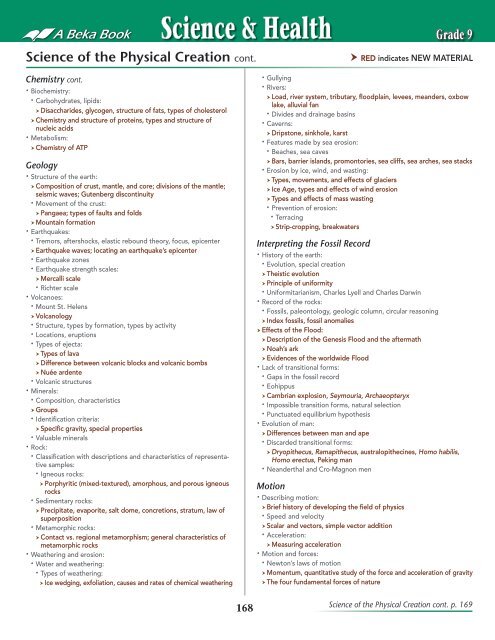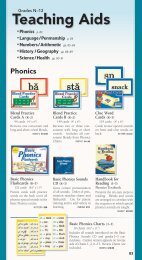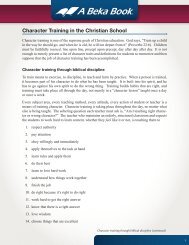Science & Health - A Beka Book
Science & Health - A Beka Book
Science & Health - A Beka Book
You also want an ePaper? Increase the reach of your titles
YUMPU automatically turns print PDFs into web optimized ePapers that Google loves.
<strong>Science</strong> & <strong>Health</strong><br />
<strong>Science</strong> of the Physical Creation cont.<br />
Chemistry cont.<br />
• Biochemistry:<br />
• Carbohydrates, lipids:<br />
h Disaccharides, glycogen, structure of fats, types of cholesterol<br />
h Chemistry and structure of proteins, types and structure of<br />
nucleic acids<br />
• Metabolism:<br />
h Chemistry of ATP<br />
Geology<br />
• Structure of the earth:<br />
h Composition of crust, mantle, and core; divisions of the mantle;<br />
seismic waves; Gutenberg discontinuity<br />
• Movement of the crust:<br />
h Pangaea; types of faults and folds<br />
h Mountain formation<br />
• Earthquakes:<br />
• Tremors, aftershocks, elastic rebound theory, focus, epicenter<br />
h Earthquake waves; locating an earthquake’s epicenter<br />
• Earthquake zones<br />
• Earthquake strength scales:<br />
h Mercalli scale<br />
• Richter scale<br />
• Volcanoes:<br />
• Mount St. Helens<br />
h Volcanology<br />
• Structure, types by formation, types by activity<br />
• Locations, eruptions<br />
• Types of ejecta:<br />
h Types of lava<br />
h Difference between volcanic blocks and volcanic bombs<br />
h Nuée ardente<br />
• Volcanic structures<br />
• Minerals:<br />
• Composition, characteristics<br />
h Groups<br />
• Identification criteria:<br />
h Specific gravity, special properties<br />
• Valuable minerals<br />
• Rock:<br />
• Classification with descriptions and characteristics of representative<br />
samples:<br />
• Igneous rocks:<br />
h Porphyritic (mixed-textured), amorphous, and porous igneous<br />
rocks<br />
• Sedimentary rocks:<br />
h Precipitate, evaporite, salt dome, concretions, stratum, law of<br />
superposition<br />
• Metamorphic rocks:<br />
h Contact vs. regional metamorphism; general characteristics of<br />
metamorphic rocks<br />
• Weathering and erosion:<br />
• Water and weathering:<br />
• Types of weathering:<br />
h Ice wedging, exfoliation, causes and rates of chemical weathering<br />
168<br />
• Gullying<br />
• Rivers:<br />
Grade 9<br />
h red indicates NeW MATerIAL<br />
h Load, river system, tributary, floodplain, levees, meanders, oxbow<br />
lake, alluvial fan<br />
• Divides and drainage basins<br />
• Caverns:<br />
h Dripstone, sinkhole, karst<br />
• Features made by sea erosion:<br />
• Beaches, sea caves<br />
h Bars, barrier islands, promontories, sea cliffs, sea arches, sea stacks<br />
• Erosion by ice, wind, and wasting:<br />
h Types, movements, and effects of glaciers<br />
h Ice Age, types and effects of wind erosion<br />
h Types and effects of mass wasting<br />
• Prevention of erosion:<br />
• Terracing<br />
h Strip-cropping, breakwaters<br />
Interpreting the Fossil Record<br />
• History of the earth:<br />
• Evolution, special creation<br />
h Theistic evolution<br />
h Principle of uniformity<br />
• Uniformitarianism, Charles Lyell and Charles Darwin<br />
• Record of the rocks:<br />
• Fossils, paleontology, geologic column, circular reasoning<br />
h Index fossils, fossil anomalies<br />
h Effects of the Flood:<br />
h Description of the Genesis Flood and the aftermath<br />
h Noah’s ark<br />
h Evidences of the worldwide Flood<br />
• Lack of transitional forms:<br />
• Gaps in the fossil record<br />
• Eohippus<br />
h Cambrian explosion, Seymouria, Archaeopteryx<br />
• Impossible transition forms, natural selection<br />
• Punctuated equilibrium hypothesis<br />
• Evolution of man:<br />
h Differences between man and ape<br />
• Discarded transitional forms:<br />
h Dryopithecus, Ramapithecus, australopithecines, Homo habilis,<br />
Homo erectus, Peking man<br />
• Neanderthal and Cro-Magnon men<br />
Motion<br />
• Describing motion:<br />
h Brief history of developing the field of physics<br />
• Speed and velocity<br />
h Scalar and vectors, simple vector addition<br />
• Acceleration:<br />
h Measuring acceleration<br />
• Motion and forces:<br />
• Newton’s laws of motion<br />
h Momentum, quantitative study of the force and acceleration of gravity<br />
h The four fundamental forces of nature<br />
<strong>Science</strong> of the Physical Creation cont. p. 169

















